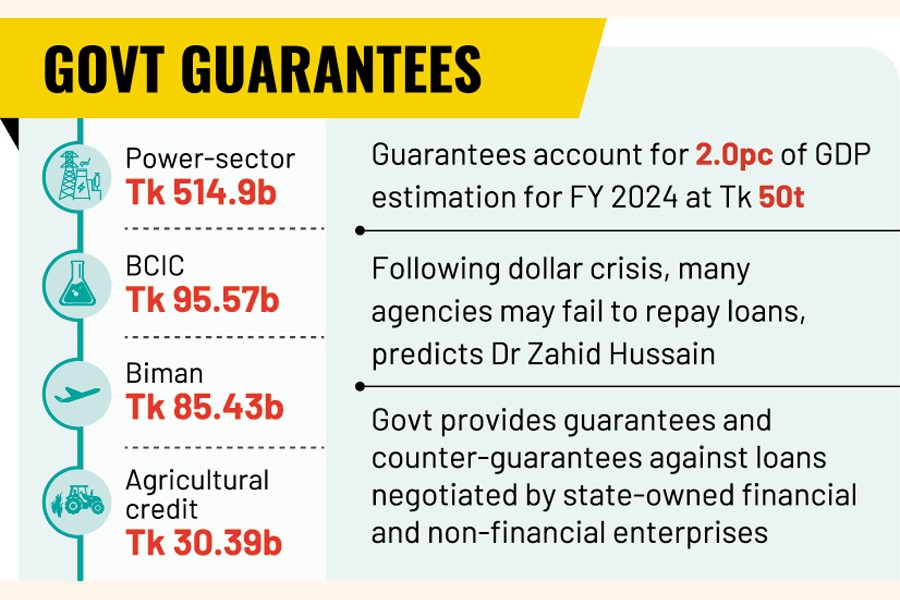Costly global fuel, fertiliser prices take a toll
Govt liabilities from SOEs’ debts swell to Tk 985.9b

Published :
Updated :

Government debt liabilities stemming from overdue loans of state-owned enterprises (SOEs) from local and foreign lenders go ballooning to Tk 985.9 billion this year amid financial upheavals, sources say.
The amount is over 6.0-percent higher than last year’s—and such growing SOE borrowings may ultimately add up to the aggregate national debt in the event of the enterprises failing to pay back the borrowed money.
The SOEs’ debt increased mainly due to higher prices of fertiliser, especially urea, and also fuel-price upturn on the international market. The dearth fuelled the BCIC guarantees up more than 39 per cent. Its guarantee valid beyond June 30, 2023 is Tk 95.57 billion.
The total power-sector guarantees alone surged to Tk 514.9 billion, nearly 4.0 per cent up from last year’s, for fuel-price rises and payments to plant owners.
Such state guarantees valid beyond June 2023 have future fiscal implications for the exchequer in economists’ view, as government’s debt-servicing liabilities are already building up in the current context in particular.
The government provides guarantees and counter-guarantees against loans negotiated by various state-owned financial and non-financial enterprises who implement different public policies and programmes.
If the contracting organisations fail to repay their loans in time, the guarantees are invoked and the liabilities for payment are passed on to the government. Consequently, they have future fiscal implications.
National carrier Biman’s guarantees provided by the government now amount to Tk 85.43 billion. The airlines took loans mainly for purchasing aircraft.
Agricultural-credit guarantees stood at Tk 30.39 billion. These loans were taken from Bangladesh Krishi Bank and Rajshahi Krishi Unnayan Bank with guarantees from Bangladesh Bank, the central bank.
The sovereign guarantees seem to be vulnerable as the loans were Tk 27.52 billion last year and went up approximately 12 per cent in a year despite the number of projects remaining the same at three.
The budget documents say there are some cumulative arrears in the loans, and for this reason, this liability shows an upturn.
Accounting for around 2.0 per cent of the GDP (GDP estimation for FY 2024 is now Tk 50 trillion), the guarantees are a matter of concern as the repayment liabilities will pass on to the government exchequer when government agencies will fail to repay the loans in time, and consequently, have future fiscal implications for the nation, analysts opine.
The government-owned financial and non-financial enterprises implement many projects and programmes and they need such state guarantees and counter-guarantees against debts. Overseas banks or financial institutions or local banks want such underwriting for lending to the agencies.
The government has to grant guarantees for the SOEs to help them borrow funds to run and expand their operations, as the organisations cannot arrange loans themselves because of their weak financial strengths.
Both local and international financiers who seek such sureties from the government at home are Bangladesh Bank, Sonali Bank, Janata Bank, Agrani Bank, and Rupali Bank. The international institutions which seek such guarantees are PEFCO, HSBC, ICBC Bank of China, Japan Bank for International Cooperation (JBIC) and Exim Bank of China.
Economists view the guarantees are part of “contingent liabilities”. And these are actually liabilities for the government in the event of default.
Dr M. Masrur Reaz, Chairman of the private think-tank Policy Exchange of Bangladesh, told the FE that those are in a sense “hidden subsidies” and also put pressure on public finances.
“These should be taken into consideration while measuring government’s overall debt. These should be taken into consideration when one is trying to gauge overall government debt,” he says.
He feels that Bangladesh’s debt-to-GDP ratio will rise sharply when these will be taken into account.
“To my mind, once these liabilities are considered, the debt-GDP ratio will be much higher.”
Dr Zahid Hussain, the former lead economist at the World Bank’s Dhaka office, told the FE that the number and the volume of liabilities rose as the government agencies, especially BADC and BCIC, needed to procure fertilisers which remained expensive last year.
“Following the dollar crisis, many government agencies may fail to repay the loans taken from overseas lenders, leading to rise in government liabilities,” the economist predicts about the country’s latest debt buildup largely stemming from the global and local financial woes.
jasimharoon@yahoo.com


 For all latest news, follow The Financial Express Google News channel.
For all latest news, follow The Financial Express Google News channel.